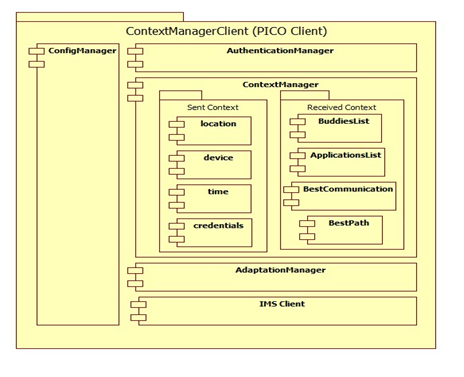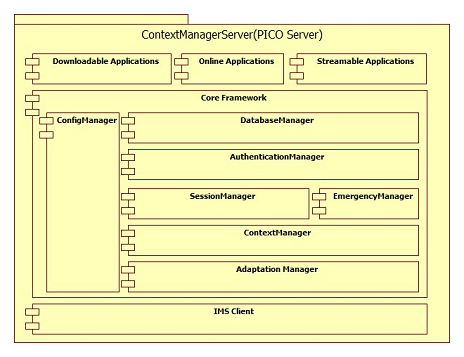Project description
Background
The last years are characterized by relevant natural disasters and intentional attacks to different infrastructures that have highlighted the deficiency of telecommunications and support systems to handle emergency situations. In many situations, telecommunication networks were heavily damaged or totally destroyed.
The concept of emergency in telecommunications addresses a broad spectrum of aspects related to the provisioning of telecommunication services in emergency situations.
Emergency situations may vary from a narrow perspective related to personal or domestic emergencies (making an emergency call due to illness, traffic accident, fire at home, etc.) to a very broad perspective of critical social situations (earthquakes, floods, large scale terrorist attacks, etc.).
The emergency concept also covers social telecommunication needs that are mainly related to resources for ensuring public safety; including police forces, fire fighting units, ambulance services and other health and medical services, as well as civil defence services. The telecommunication needs of such services have been satisfied by dedicated networks and equipment for different services so far. Service adaptation and Context-Awareness are key points in mobile and ubiquitous computing. Applications on mobile devices use context information to adapt themselves to changing environments.
PICO Project Architecture
PICO is a project carried out in collaboration with CEFRIEL and Politecnico di Torino. PICO aims at the distribution of innovative telecommunication services for differentiated users in emergency situations, related to both prevention and consequent participation in case of natural catastrophes.
The key points of the project are mainly related to:
PICO Client
Each client is a device of next generation and performs all the required operations that the prototype offers. The device must have, at least:

Figure 1. PICO Client
PICO Server
The Context Manager Server (CMS) enables to the Context Manager Client (CMC) the access to the services and applications. The CMS can be considered as an application server that extends IMS functionalities. It can be identified as an IMS client with special functions.

Figure 2. PICO Server
Figure 2 shows the internal view of the Context Manager Server. It contains the next elements:

Figure 3. Example of context updates from Context Manager Server
Conclusions
The main result of this work is a robust and reliable context-aware prototyped supported by IMS features, that provides relevant information and/or services/applications based on current user context. Providing effective and proper resources (e.g., behavior policies, applications on-demand) in order to face critical situations, is a procedure that depends on how a Context-Aware application is customized according to the current situation and how effective is the platform. The platform is able to handle the interaction between the different actors (e.g., Context Manager Server, Context Manager Client, SIP Server).
The last years are characterized by relevant natural disasters and intentional attacks to different infrastructures that have highlighted the deficiency of telecommunications and support systems to handle emergency situations. In many situations, telecommunication networks were heavily damaged or totally destroyed.
The concept of emergency in telecommunications addresses a broad spectrum of aspects related to the provisioning of telecommunication services in emergency situations.
Emergency situations may vary from a narrow perspective related to personal or domestic emergencies (making an emergency call due to illness, traffic accident, fire at home, etc.) to a very broad perspective of critical social situations (earthquakes, floods, large scale terrorist attacks, etc.).
The emergency concept also covers social telecommunication needs that are mainly related to resources for ensuring public safety; including police forces, fire fighting units, ambulance services and other health and medical services, as well as civil defence services. The telecommunication needs of such services have been satisfied by dedicated networks and equipment for different services so far. Service adaptation and Context-Awareness are key points in mobile and ubiquitous computing. Applications on mobile devices use context information to adapt themselves to changing environments.
PICO Project Architecture
PICO is a project carried out in collaboration with CEFRIEL and Politecnico di Torino. PICO aims at the distribution of innovative telecommunication services for differentiated users in emergency situations, related to both prevention and consequent participation in case of natural catastrophes.
The key points of the project are mainly related to:
- Distribution of services and applications on heterogenous devices (Application Streaming)
- User Profilation (Context-Aware)
PICO Client
Each client is a device of next generation and performs all the required operations that the prototype offers. The device must have, at least:
- video camera to perform videoconferencing and allowing recording user sights;
- microphone to perform audio calls;
- GPS device to perform the geo-location.
- IMS client: This subsystem is responsible of implementing all the IMS client features required by the Context Manager Client. The most important IMS features supported are user authentication into the IMS system, audio/video call setup, presence service and Instant Messaging (IM). More generally, the IMS client manages all the multimedia sessions required by the Context Manager Client (CMC). It also exports a proper set of APIs to the other Context Manager Clients subsystems. Moreover IMS client implements the MSRP protocol to allow file transfer, and more precisely it provides the application transfer from the Context Manager Server;
- Base Features: Client core;
- User Driven Applications: It collects all the applications required by the client during the operations that are specified according to the user profiles and needs;
- Device Driven applications: This subsystem collects all the applications required by the CMC during the operations that are specified according to the device type and the equipment installed on it.

PICO Server
The Context Manager Server (CMS) enables to the Context Manager Client (CMC) the access to the services and applications. The CMS can be considered as an application server that extends IMS functionalities. It can be identified as an IMS client with special functions.

Figure 2 shows the internal view of the Context Manager Server. It contains the next elements:
- User Profile: all the users have a user profile that describes the configuration for a specific user, including the user's access permission for the applications on demand, user type (FF, LE or EMS) and preference settings;
- Service Authorizations: this module sets the authorization for the service required at each user level;
- Downloadable Applications: these are the downloadable applications on demand;
- Online Applications: applications on demand that are directly on line when the user performs the authentication procedure;
- Stream Applications: applications that can be streamed on demand;
- Mobility: this module manages mobility among the three IMS architectures (FF Network, LE Network and EMS Network);
- Core framework: this module performs all the basic functionalities;
- IMS client: performs IMS functionalities and allows: registration on IMS, session invite, file transfer using MSRP protocol and so on;
- Reasoner: performs reasoning based on rules that considers characteristics associated to the kind of emergency, specific area and users location;
- Context: manages all Context parameters based on GEO Coordinates of the users, the battery level of the device, network traffic and so on.

Figure 3. Example of context updates from Context Manager Server
Conclusions
The main result of this work is a robust and reliable context-aware prototyped supported by IMS features, that provides relevant information and/or services/applications based on current user context. Providing effective and proper resources (e.g., behavior policies, applications on-demand) in order to face critical situations, is a procedure that depends on how a Context-Aware application is customized according to the current situation and how effective is the platform. The platform is able to handle the interaction between the different actors (e.g., Context Manager Server, Context Manager Client, SIP Server).
